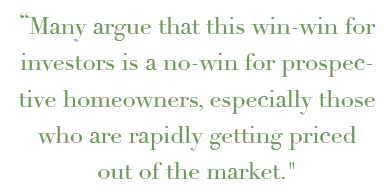
Let’s start with REITs.
REITs, or real estate investment trusts, are often referred to as “real estate stock.” REITs are corporate entities that own a portfolio of properties and/or mortgage loans. Anyone can buy shares in a publicly traded REIT, and they are an attractive option for investors, since they offer the benefits of property ownership without the hassles of being a landlord.
REIT shares can be sold quickly, providing the key advantage of liquidity. There is also higher yield and less risk, since the investment is in an entire portfolio of properties, not just one or two.
REITs came into being in 1960, when Congress decided to made it possible for smaller investors to invest in large-scale, income-producing real estate via the purchase of equity, the same way one can buy stock in corporations in any industry.
Types of REITs
REITs generally fall into three categories: equity REITs, mortgage REITs, and hybrid REITs, with equity REITs (a.k.a. eREITs) being the largest category. Equity REITs own and manage income-producing real estate, which are acquired through bulk sales at discount prices directly from banks. Mortgage REITs, on the other hand, earn money either in the form of interest on mortgage loans or through the acquisition of mortgage-backed securities. Hybrid REITs invest in both properties and mortgages.
Investment trust firms benefit from the discount prices obtained from bulk purchases, enabling them to yield higher and faster returns. Banks enjoy the clear and much-needed benefit of being able to dispose of large volumes of non-performing assets without having to pay administrative costs, maintenance costs and broker fees to list each one separately. However, what is good for banks and investors is seldom good for the average homeowner.
Concerns
Some argue that regulators should expand their oversight of the large REITs that use borrowed money to invest in mortgage-backed securities, as the rise in interest rates may lead the firms into asset sales that destabilize markets and potentially damage the broader U.S. economy. The reliance by the industry on short-term loans to invest in government-backed mortgage securities involve interrelated risks, and should be monitored closely to reduce the risk of a cascading failure of counterparties with systemic implications. Sizable disruptions in the secondary mortgage markets against the possibility of rising mortgage rates could also have macroeconomic implications, jeopardizing the already-fragile housing market recovery.
The New Landlord
Most of us thought the single family rental market was robust before the housing market crash, with sixteen million SFRs already designated as rentals in 2010. If we add to the mix approximately five million foreclosed homes, and consider that many of them will become investor-owned rental units, we begin to see the enormity of the impact of bulk SFR sales that are allocated as rentals. Thus, the REO-To-Rental market has emerged as an institutional asset class.
 The bulk sale-to-rental model provides a long-term rental income stream as well as the opportunity for appreciation. Consider the fact that these bulk sales are contributing to an inventory shortage on the open market, which means the model itself is ensuring faster appreciation as home prices increase due to limited supply. Many argue that this win-win for investors is a no-win for prospective homeowners, especially those who are rapidly getting priced out of the market. And those who get priced out of the market most likely end up renting, further feeding into the bulk sale investor’s win-win scenario.
The bulk sale-to-rental model provides a long-term rental income stream as well as the opportunity for appreciation. Consider the fact that these bulk sales are contributing to an inventory shortage on the open market, which means the model itself is ensuring faster appreciation as home prices increase due to limited supply. Many argue that this win-win for investors is a no-win for prospective homeowners, especially those who are rapidly getting priced out of the market. And those who get priced out of the market most likely end up renting, further feeding into the bulk sale investor’s win-win scenario.
What do critics say?
Many housing industry professionals are objecting to bulk foreclosure sales, considering them a gift for investors at the expense of taxpayers and prospective home buyers, and calling for changes at the Federal Housing Finance Agency (FHFA), the agency that initiated the program. While the bulk sale-to-rent program was initiated by the FHFA to help Fannie and Freddie unload thousands of foreclosed assets weighing down their books, banks began to quickly follow suit to dispose of bulk assets. When you consider that Fannie and Freddie own approximately 200,000 homes, and the nation’s banks own close to 600,000 homes, it is a feasible argument that the shift toward bulk sales will inevitably slow or halt the recovery of the housing market.
Although economic indicators show that the housing market is improving, many believe that tightened lending restrictions, negative equity, the deleveraging of borrowers and lenders, and the overhang of delinquencies will continue to suppress owner-occupied home sales while increasing the percentage of renters. If a large chunk of purchases are by investors and REITs, only investors benefit, and individual buyers and real estate professionals are excluded from the marketplace. We are looking at an entirely different real estate market with rapid gains in momentum down this path.
Bulk Sales inhibit the social benefits of home ownership – our government has historically recognized the stability that home ownership brings to communities, particularly urban communities. Programs such as the Community Reinvestment Act of 1977 served to boost ownership amongst those who would otherwise be shut out of the home ownership opportunity. Transferring increasing numbers of properties to big fund investors may turn the U.S. into a nation of renters instead of a nation of owners.
In an industry already devastated by dramatic reductions in earnings and inventory, bulk sales are forcing more and more real estate professionals to abandon their careers. The ‘shadow inventory’ or 2nd wave, that was once a buzzword that held promise among real estate professionals, has not yet made it to the market, and it is hard to predict at this point how much (if any of it) will. Another looming concern is that bulk sales may lead lenders to move back into the practice of direct selling in competition with agents, a clear conflict of interest.
Conclusion
While bulk sale purchases may yield significant ROIs for investors, the housing market at the MLS level will suffer from the loss of properties, which feeds a rise in home prices bolstered by the massively disruptive speculator intrusion. Many housing industry professionals will leave the industry. Future home buyers are left to wrestle with the consequential inflated housing prices, as critics accuse the FHFA of choosing to support investors instead of Americans that want a home to own and live in.
Despite such concerns, there is reason to believe that bulk sales to REITs, under a watchful eye, can help lighten the burden of REO inventory, which remains heavy. RealtyTrac estimates that the industry still has some 600,000 bank-owned homes to sell, and they can’t all go to bulk sale. Will the industry adapt?

 Login
Login
